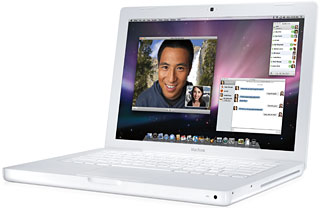Since the Unibody
MacBooks made their entrance last October 14, very little attention
has been paid to the mildly updated holdover entry-level 2.1 GHz MacBook White that was
announced at the same time - and most of what has been said is focused
narrowly on the price cut to $999 from $1,099 for the previous
entry-level model.
The last representative of Apple's best-selling notebook computer
model ever really deserves more respect than that.

The white MacBook
I suppose that it's partly because the polycarbonate-bodied 13.3"
MacBook, a conventional machine that owed much in terms of styling to
the iBooks it replaced, was never terribly exciting at the best of
times. The dual USB iBook form factor had been around what seemed like
forever (five years), and had it not been for the availability of a
black MacBook, albeit at a hard-to-justify $200 price premium for some
black pigment in the polycarbonate resin its case was molded from and a
somewhat larger hard drive, it would have been even a bigger yawner
aesthetically.
Now that the MacBook has been in production for just shy of three
years, it just can't compete for attention with the swish new Unibody
model.
'Old School' Virtues
However, the "old school" MacBook still has its virtues, one being
that it sells for $300 less than the 2.0 GHz Unibody MacBook. It is
also the last Apple portable with a FireWire 400 port and the only
consumer MacBook with any sort of FireWire support, which is huge for
some users.
It's also easy to forget how well-endowed all Macs really are,
including this price-leader MacBook and even the Mac mini. The base MacBook comes
with a Penryn Core 2 CPU with an enhanced SSE4 vector engine and a
3 MB level 2 (L2) cache shared by both cores that's actually
faster than the base Unibody's CPU (although the MacBook White runs on
a slower, 800 MHz frontside bus), Apple's iLife suite of applications
bundled, and iSight camera, a better array of I/O ports than the
upmarket unibodies, a MagSafe power adapter, and, of course, Mac
OS X.
Okay, the truly price conscious and those with really constraining
budget realities are just not going to get excited over a $1,000
notebook, even if it is a Mac, when they can get a pretty decently
featured PC "netbook" for $300, but in the context of Apple notebook
history, this 2.1 GHz Core 2 Duo unit offers the most power and
features for your purchase dollar you've ever been able to get - much
more than the last $999 Apple notebook - a G3 iBook - ever
represented.
Looked at from that perspective, it's a bit of a steal.
'Old School' Drawbacks
Of course, the 2.1 GHz MacBook is well short of perfection, even if
it does now come with an 8x dual-layer SuperDrive. Serious gamers (or
even many casual ones) would not even consider one of these machines in
light of the plastic MacBook's most serious Achilles' heel - the
mediocre video supported by its slow Intel GMA X3100 integrated
graphics that uses 144 MB of system memory for graphics, an issue that
has been dealt with handily in the new aluminum MacBooks, which boast
the all-new Nvidia GeForce 9400M integrated graphics that Apple claims
are up to five times faster than the X3100 can manage.
That said, if you're not a serious gamer and don't use your laptop
for higher-end graphics or video editing, you will probably find the
old school MacBook's graphics performance more than adequate (although
one other point to consider is that OS X 10.5.6 "Snow Leopard"
reportedly leans a lot more heavily on its supporting hardware's
graphics system than previous versions of OS X have).
Another caveat is that while the old school MacBook's polycarbonate
case is supposedly extremely tough and claimed by some to do a better
job of absorbing knocks and bumps when you take your laptop on the road
than metal-skinned machines, throughout its model run some owners have
complained about cases cracking. You can read more about that issue in
Apple's
forums and at MacInTouch.
The MacBook's standard 120 GB hard drive offers a serviceable,
although not cavernous, capacity by today's standards, but it's really
easy to upgrade the hard drive. It also includes a not really adequate
1 GB of RAM, but that can be expanded to a very respectable
4 GB. The 13.3" 1280 x 800 resolution glossy display has a tried
and true CCFL backlight instead of the snazzy new LED backlighting in
the Unibody MacBook, and its battery provides a competitive 4.5 hours
of runtime.
A Proven Design
An awful lot of people have bought these MacBooks in their various
revisions, and the case crack issue notwithstanding, reliability horror
stories have been relatively rare. The design has to be pretty
thoroughly debugged by now, and if you prefer known-quantity mature
technology, then this is your machine among current Mac laptop
offerings.
And if you want one, the opportunity to buy new may be drawing to a
close. There were rumors prior to Macworld Expo that the 2.1 GHz
MacBook would be discontinued. That hasn't happened yet, but I deduce
that Apple will not want to continue the manufacturing, parts sourcing,
and inventory complication of building two completely distinct families
of MacBook indefinitely, so that at some point - likely not far off -
the plastic model will be replaced by an entry-level Unibody MacBook.



